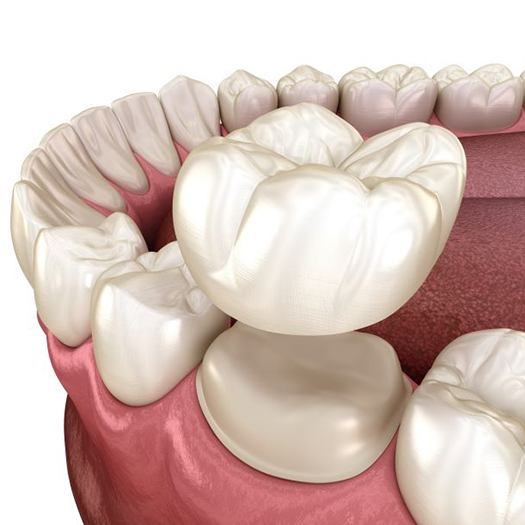Dental Crowns – San Antonio, TX
Restore Damaged and Decayed Teeth

Here at Orbis Dental Group in San Antonio, we want to help you retain your natural smile for as long as possible. In some cases, that means we must provide dental crowns to restore damaged and decayed teeth. We always use beautiful and strong materials that are designed to stand the test of time. Read this page to learn some basic facts about dental crowns, and get in touch with us when you would like to book a restorative dentistry consultation.
Why Choose Orbis Dental Group for Dental Crowns?
- Aesthetically Pleasing, Top-Quality Materials
- Detail-Oriented Dentists and Team
- Patient Wellness Is Our Top Priority
What Is a Dental Crown?

A dental crown is a custom “cap” that covers the entire portion of a tooth that is visible above the gumline. Its job is to restore the shape, strength, and function of a damaged or decayed tooth. Our practice provides beautiful, tooth-colored crowns that are made of porcelain, eMax (a specific type of porcelain), and zirconia.
We often recommend a dental crown if:
- A tooth has spots of decay that cannot be repaired with a filling.
- A tooth is badly chipped or cracked.
- A tooth has become worn-down due to years of teeth grinding and clenching.
- You wish to improve the appearance of a specific tooth.
The Process of Getting a Dental Crown

The dental crown process usually requires at least two appointments During the first appointment, we will prepare your tooth to fit beneath your restoration. In many cases, we have to remove a bit of enamel. Once your tooth is ready, we will use an advanced scanner to capture a digital impression of your teeth.
A dental lab will use that impression to fabricate your crown. In the meantime, you will wear a temporary crown to protect your tooth. When your permanent restoration is ready, we will verify that it lives up to our rigorous quality standards before we attach it to your tooth.
The Benefits of Getting a Dental Crown

A dental crown can deliver a number of benefits:
- Improved dental function. Your restoration can equip you to bite comfortably and easily consume all of your favorite foods.
- Avoid extractions. In many cases, a crown can preserve a tooth that would otherwise need to be removed.
- Crowns can be used as part of a treatment plan for several different oral health conditions.
- Beautiful aesthetics. We carefully design crowns so they look as natural as possible.
- Easy maintenance. Keeping a dental crown in good shape requires the same basic best practices that are necessary for natural teeth. With proper care, your crown might last for 10 – 15 years or longer!
Dental Crowns FAQs
What Are Dental Crowns Made Of?
Dental crowns can be made of a variety of materials. For example, many practices use metals like gold, silver, nickel, and palladium. Such options are durable, but many patients dislike them due to their noticeable appearance. Some people also have concerns about metal allergies and sensitivities.
In our office, we favor metal-free crown materials, including porcelain, eMax (a brand name of porcelain), and zirconia. These options are strong and feature a lifelike appearance.
How Long Do Dental Crowns Last?
On average, dental crowns last 5 – 15 years, though the lifespan of your restoration could be longer or shorter than that. It depends largely on how you care for your mouth. You may be able to extend your crown’s lifespan by sticking to good habits. For example, you should have a thorough oral hygiene routine, eat a balanced diet, and wear a mouthguard when you play sports. It is also important to attend regular dental checkups.
How Do You Know When a Dental Crown Needs to Be Replaced?
The only way to know for certain whether a crown needs to be replaced is to visit a dentist for an exam. However, you may notice some signs and symptoms as your crown is approaching the end of its life:
- If the tooth beneath your crown has suffered damage or decay, you may experience significant pain and sensitivity.
- Noticeable signs of damage. If you see that your crown looks broken or is severely discolored, you should seek professional care.
- If it feels like your crown is loose, it may need to be replaced or repaired.
- Dark line at the crown’s base. Some crowns have a metal interior and porcelain exterior. Eventually, a dark line can appear at the crown’s base. This issue is not only aesthetically unappealing, but it could also indicate that the crown has suffered significant wear and tear.
What Is the Difference Between Traditional and Same-Day Crowns?
The biggest differences between traditional and same-day crowns are:
- Creation method. Traditional crowns are made in third-party dental labs, whereas same-day crowns are made with the help of CAD/CAM technology right here in our office.
- Treatment timeline. Designing and placing a traditional crown can require multiple dental appointments spread out across a few weeks. Same-day crowns can usually be placed in a single appointment.
- Traditional crowns can be constructed of many different materials, whereas same-day crowns are always made of ceramic.

